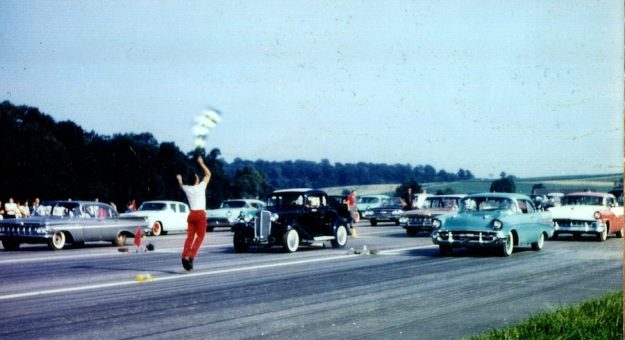“I think they held only one race that fall and when you went through the gate, they gave you a piece of paper explaining what drag racing is and what all the classes were,” McLaughlin said. “In the club, I used to ride with a girl who worked in the timing tower, making out E.T. slips. The stocks would come up through the grass and you’d check for the seat belt, brakes, steering alignment. Jenkins checked the engine and looked under the hood. He caught a lot of people.”
Living near the Susquehanna River in Columbia, Pa., McLaughlin recalls that York was wide enough that cars could race four abreast, at least for a time.
“It was Holtz’s idea to go four abreast and once I had Dave Strickler, Jenkins, Bud Faubel and Dick Collins in their Super Stock cars, and I’d be flagging them, trying to get them to back up and nod when they were ready. I did it three or four times and finally just threw the flag. Another time, I got to flag Chris Karamesines and Don Garlits. You’d tear up, with little pieces of rubber flying all around you and the ground shaking.”
The track raced in its early years with McLaughlin as one of its flagmen. The track’s equipment, including the timing clocks, was hauled in behind a pickup truck in a makeshift trailer that early York racers called the Bird Feeder. Later, York switched to a primitive home-built Christmas tree, with the tree assembled from discarded heavy pipe.
York had a short shutdown area that ended at U.S. 30 and McLaughlin recalls at least one motorist getting sideswiped by an errant race car that got onto the highway. Occasionally, the airport control tower would ring a phone in the starter’s booth, warning to stop the action because of an inbound aircraft.
McLaughlin left the track when he married in 1965, just before the track first hosted what would become its signature event, the Super Stock Magazine Nationals, which inspired longtime National Hot Rod Ass’n division director Darwin Doll to dub the meet “the Woodstock of Drag Racing.”
Jeff Golden, who witnessed this era of drag racing, was a track employee until some of its final days, and is now the drag racing curator at the Eastern Museum of Motor Racing in York Springs, Pa.
“At the first Super Stock Nationals, they booked a lot of people in to race, but they had no idea what was going to happen,” Golden recalled. “They had big purses to attract people from all over the country. It was so full that you couldn’t get into the place. They didn’t have any paved pits yet and I’ve seen photos of them parking people out in the cornfields. You couldn’t get a quart of milk for about 10 miles. The admission was just a couple of bucks but because of that, they had to haul the gate purse around in a wheelbarrow. There was that much cash.”
Golden started as a racer at York in 1972, was hired by the track two years later and stayed as race manager from 1974 through ’78, shortly after York ran briefly under American Hot Rod Ass’n sanction and hosted one of its major events. He recalls that York routinely drew 300 to 400 race cars every Saturday despite the fact it shared acreage with a functioning airport.
As Golden remembers, a local paving firm took part ownership of the track in the 1970s after it discovered a paving bill that had never been paid. Working with Hostetter, the firm put money into the strip and financed improvements, including painting.
The effort was rewarded when the NHRA named York U.S. 30 Dragway as its divisional track of the year in the northeastern United States and eastern Canada. As a measure of its appeal, Golden noted York’s mailing list was still dominated by racers from Lancaster County, with other competitors hailing from Maryland and Delaware.
Golden speculates that York was strongest at drawing from Lancaster because another NHRA strip, Maple Grove Raceway, was located farther east and north, near Reading, Pa. York ended up as part of an impromptu two-day circuit with the eighth-mile track known as Quarter Aces, and now South Mountain Dragway in Boiling Springs, Pa., outside Carlisle.
York suffered from two slow seasons in 1977 and ’78, due in part to excessive rainouts. At the same time, the track was coming under serious pressure from airport management, which wanted to install an advanced instrument landing system. According to Golden, that ILS technology still has yet to be installed, but he sensed the end was near and left York in late 1978. The end came in October 1979.
“Ultimately, the airport was what closed the track,” he reminisced. “The drag strip was a pain because it cost the airport money and the airport just coasted along, despite being sold several times. When it closed in October 1979, nobody really knew that they wouldn’t be turning the lights on again. Ultimately, nobody really knew that the end was coming.”

